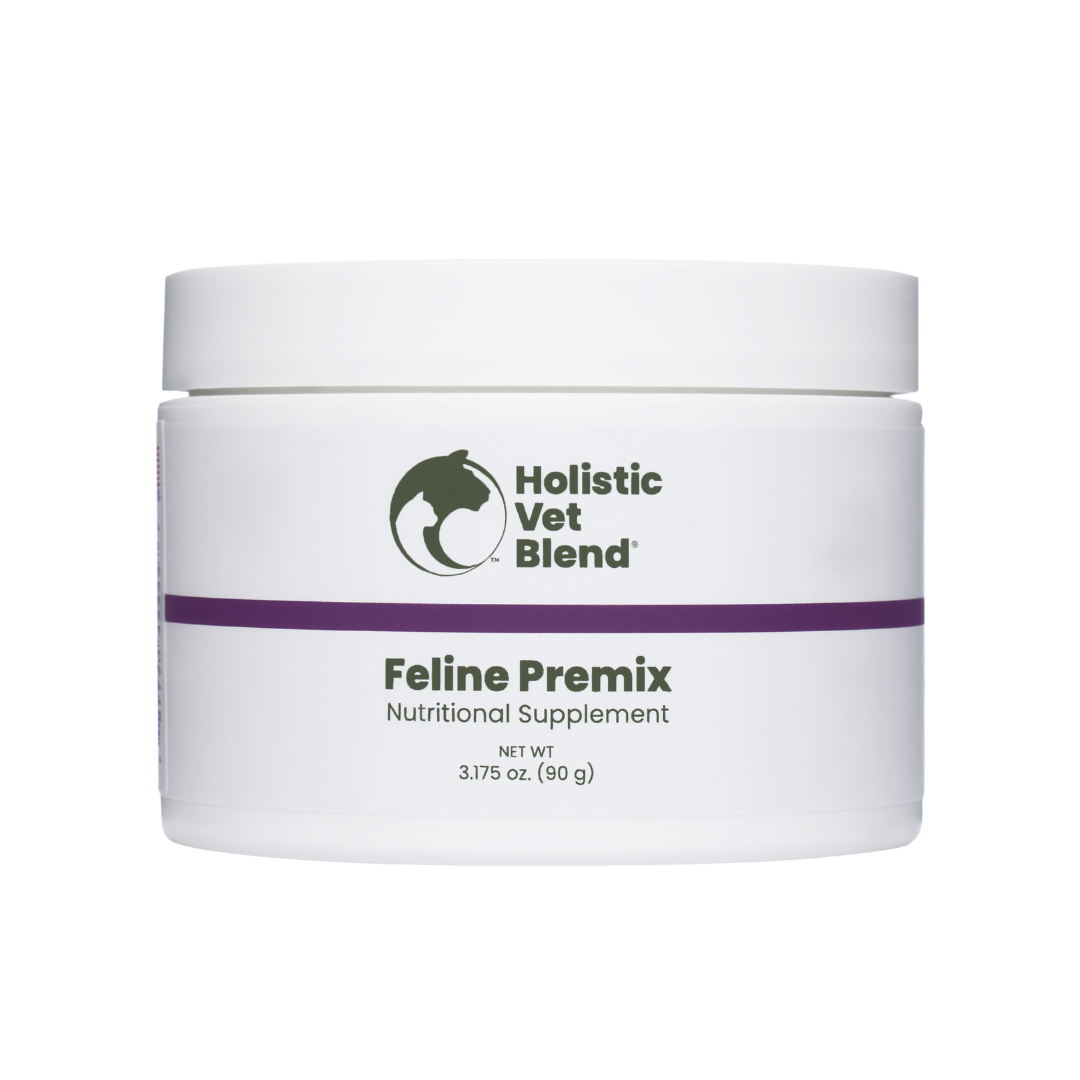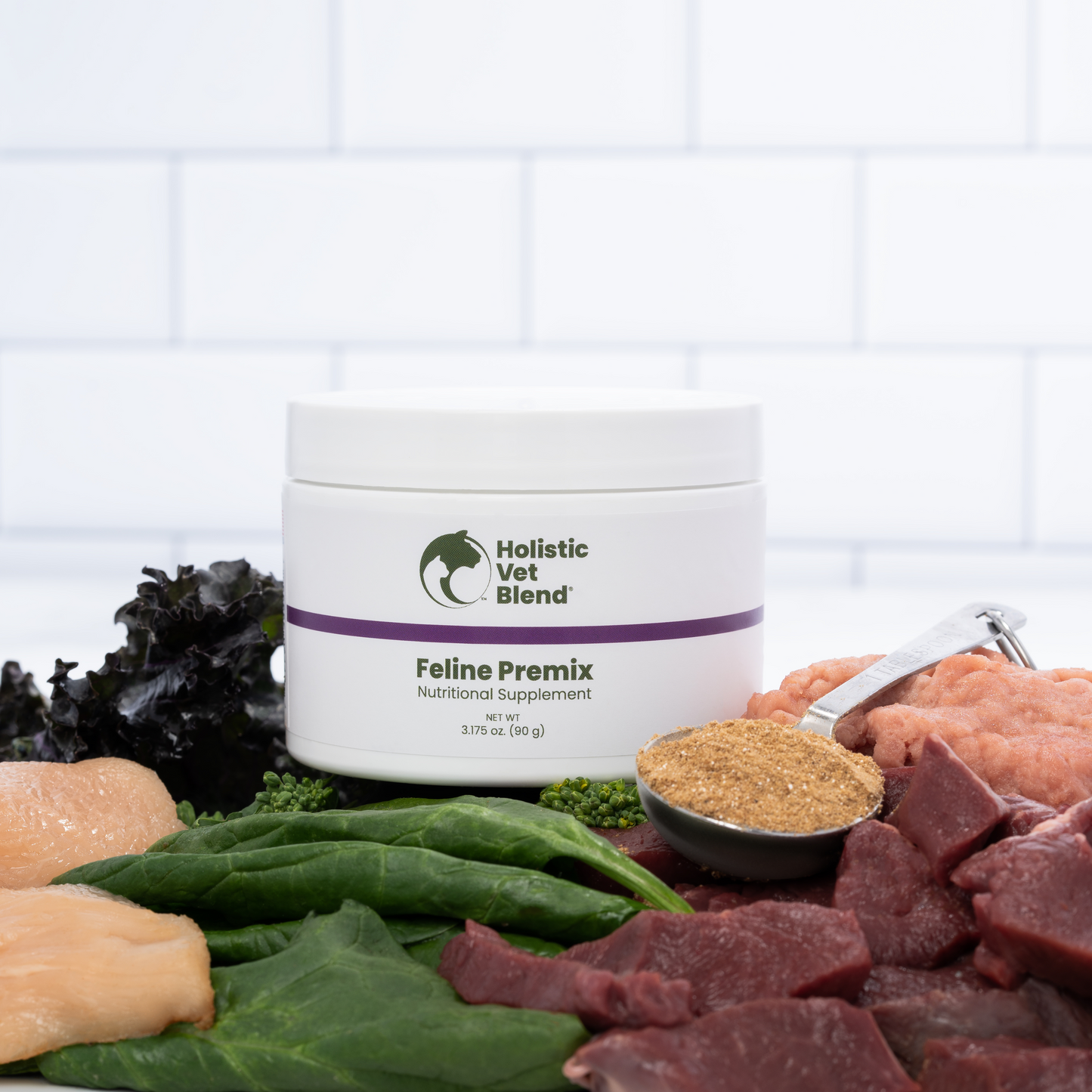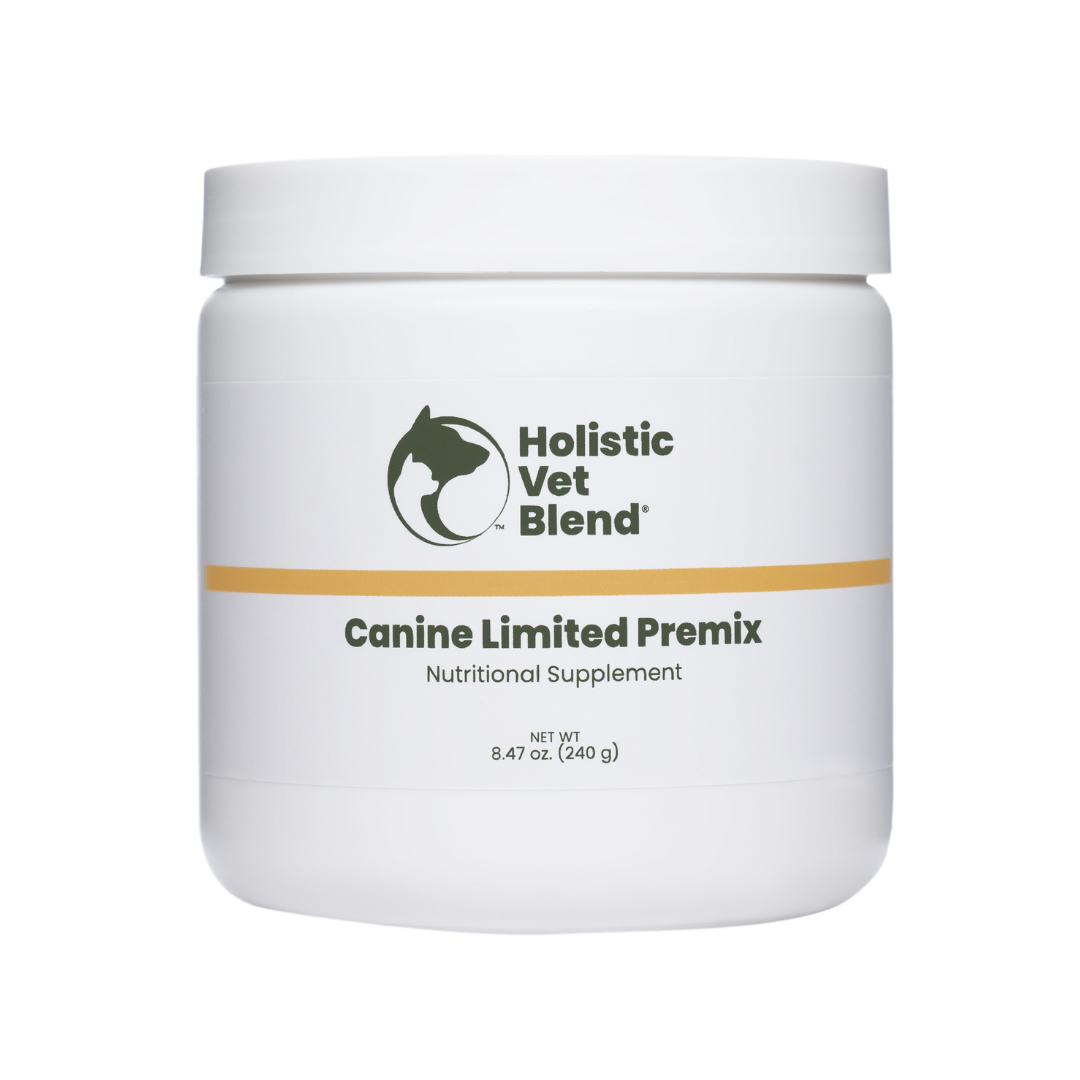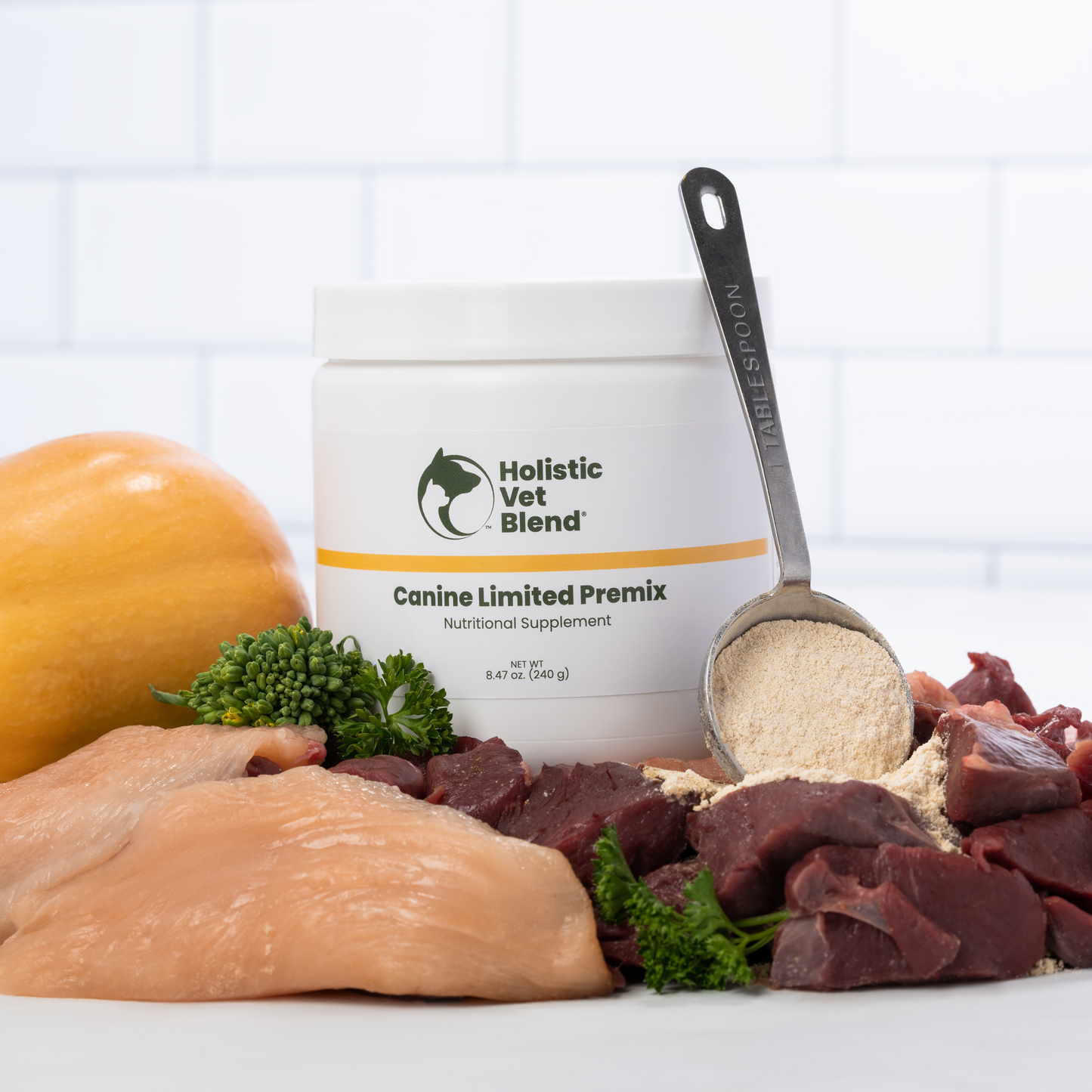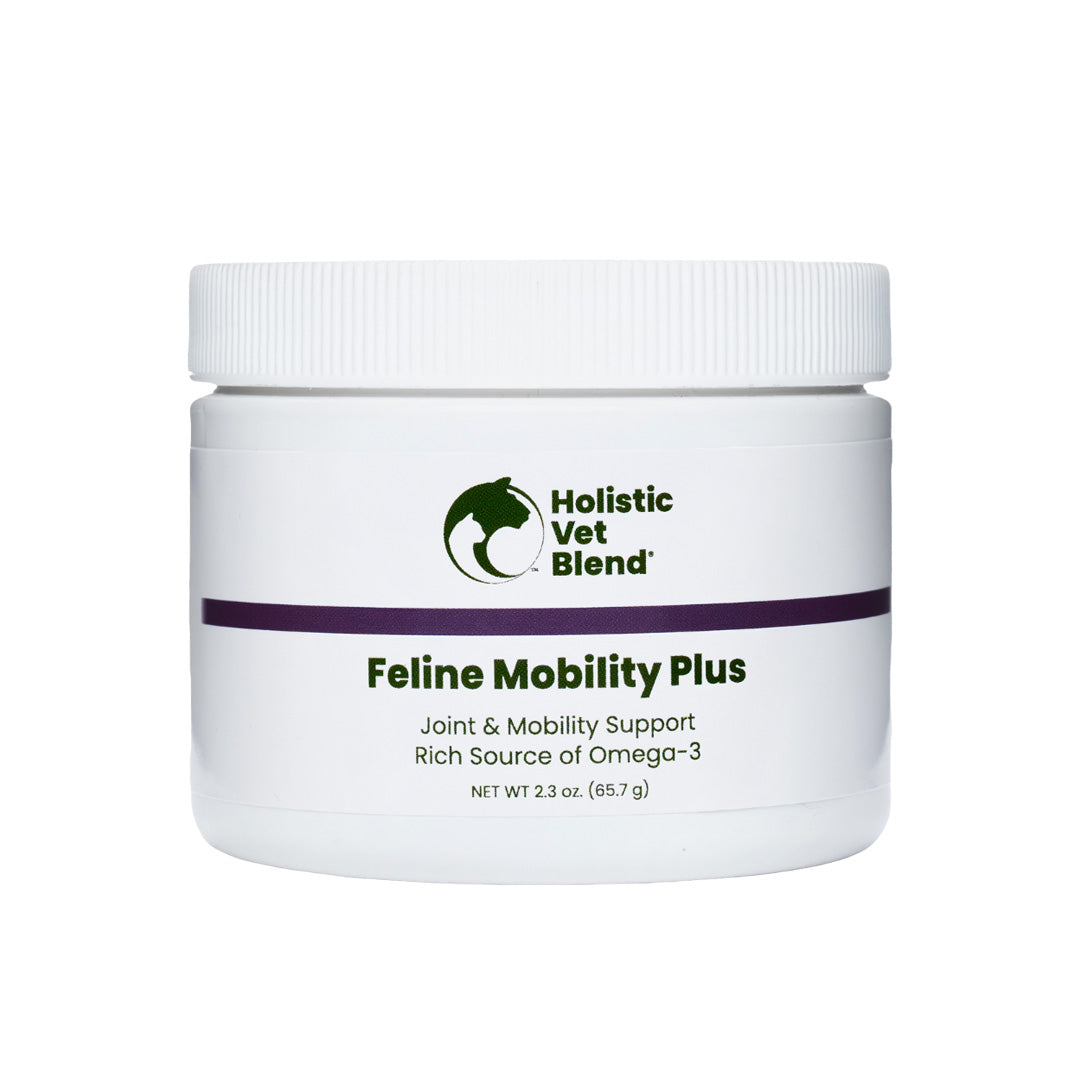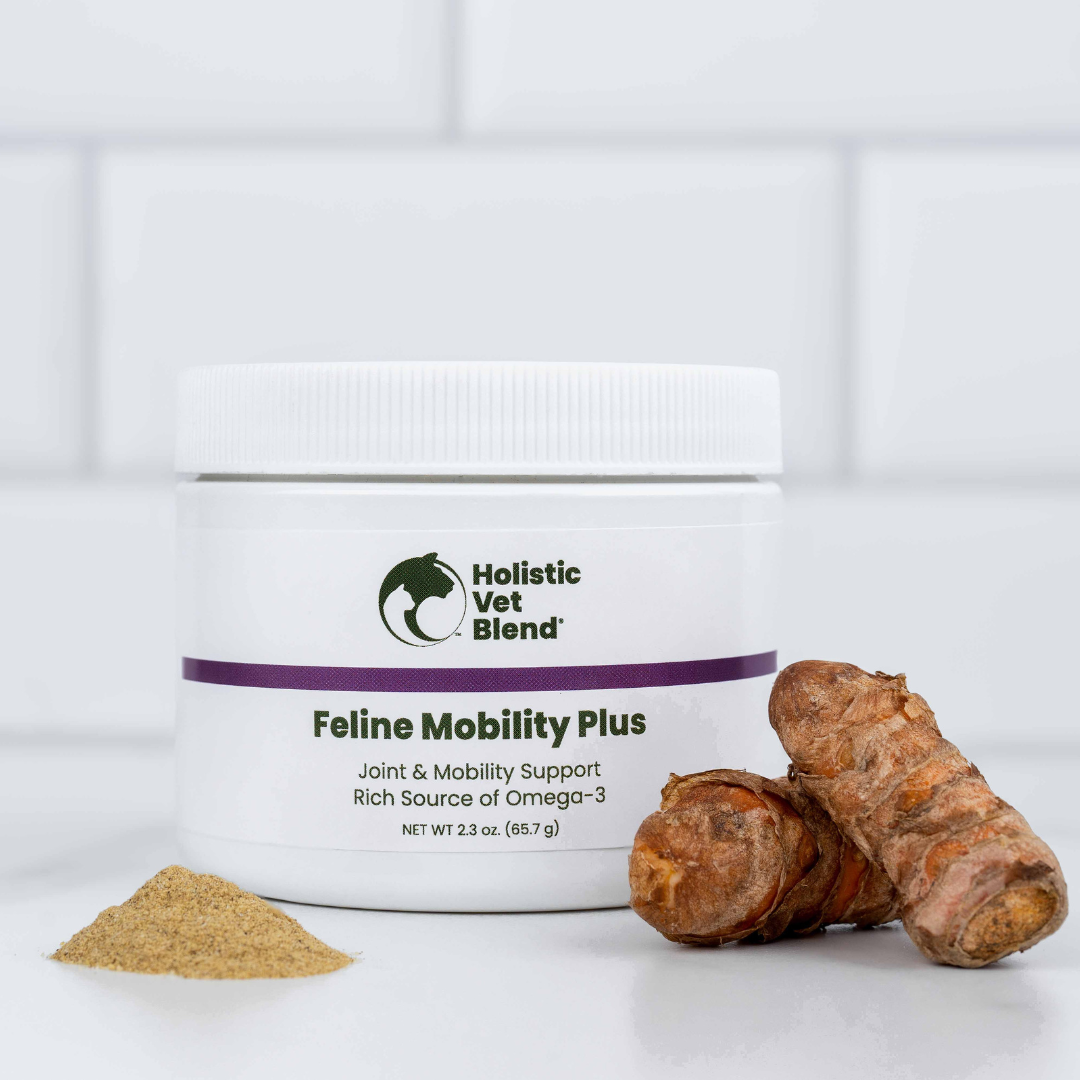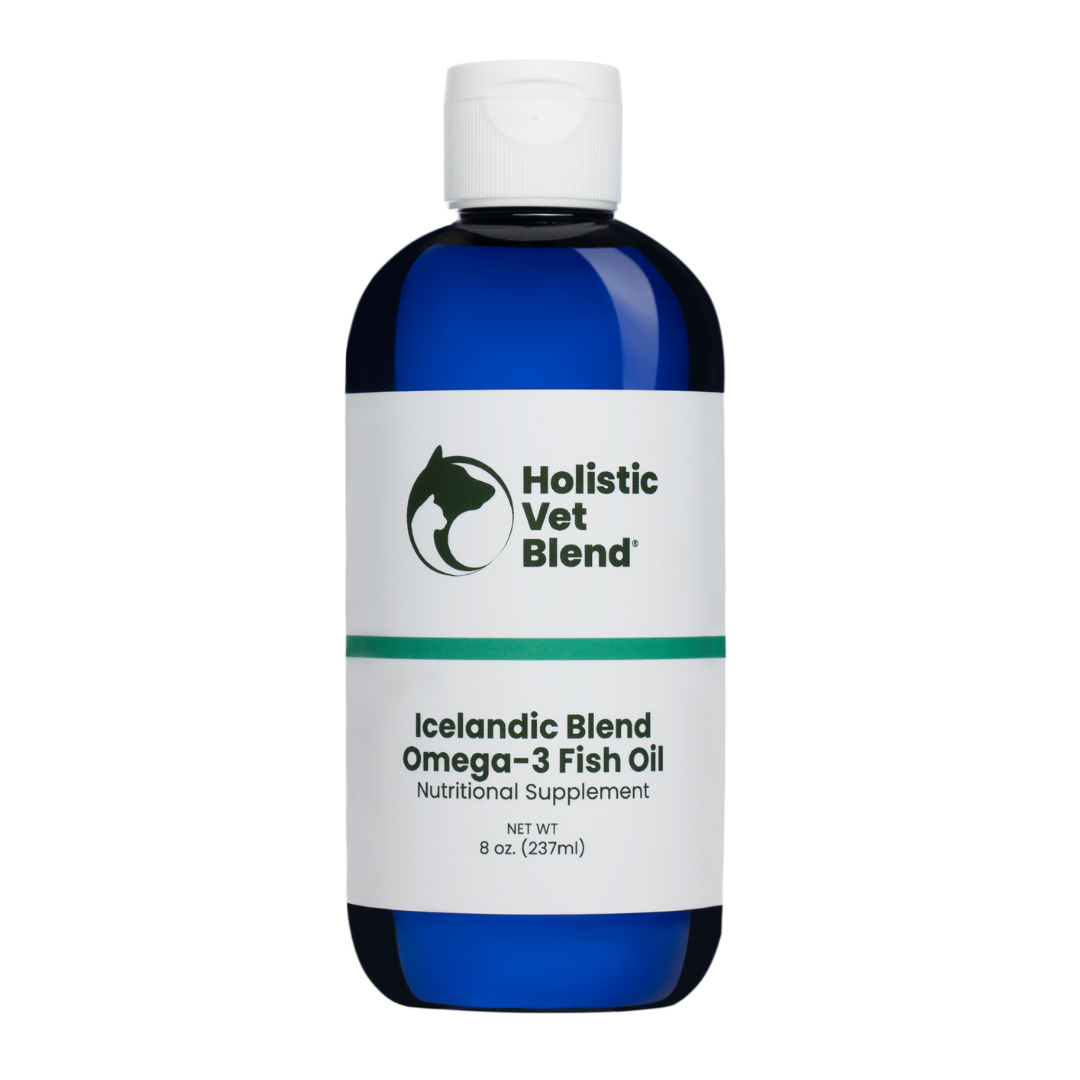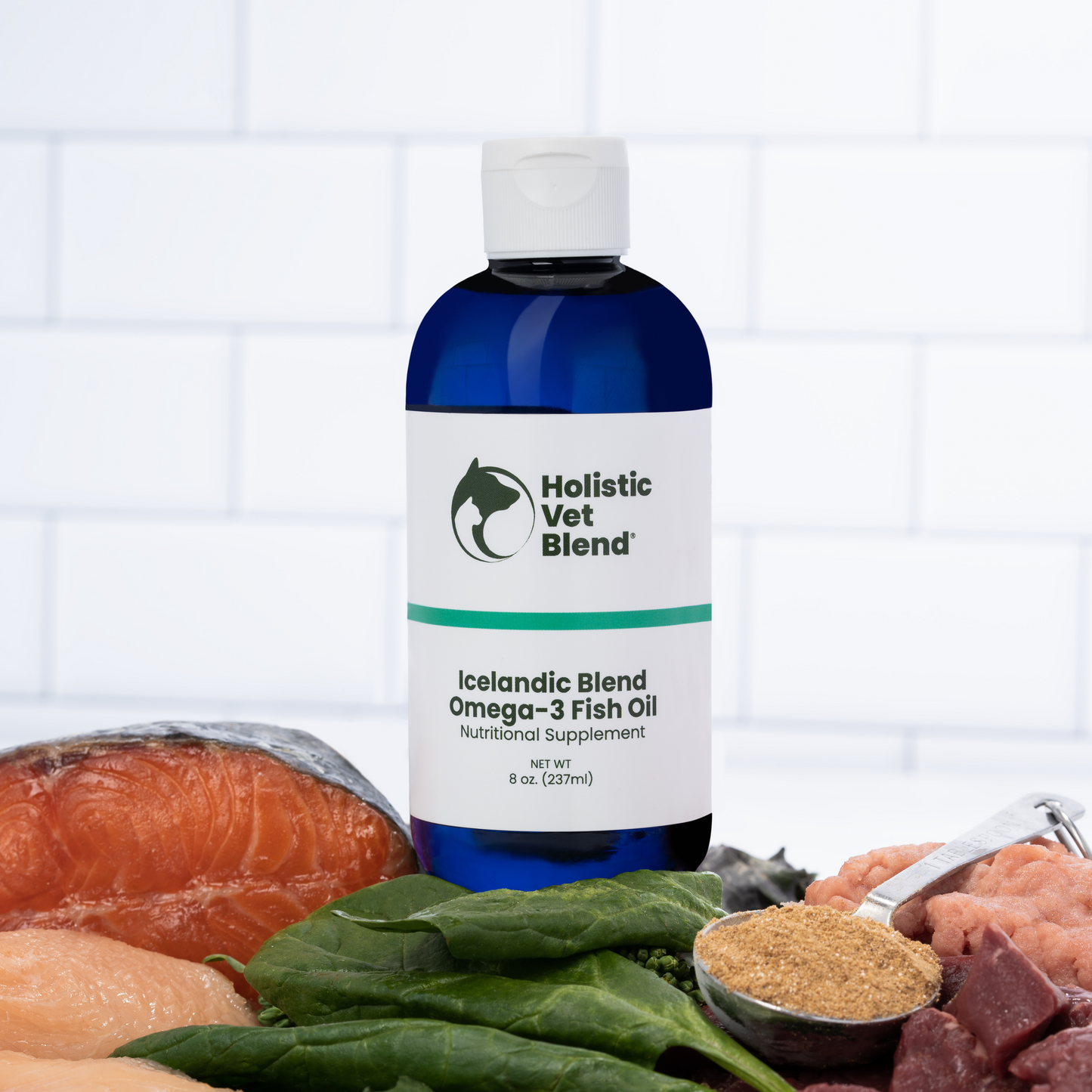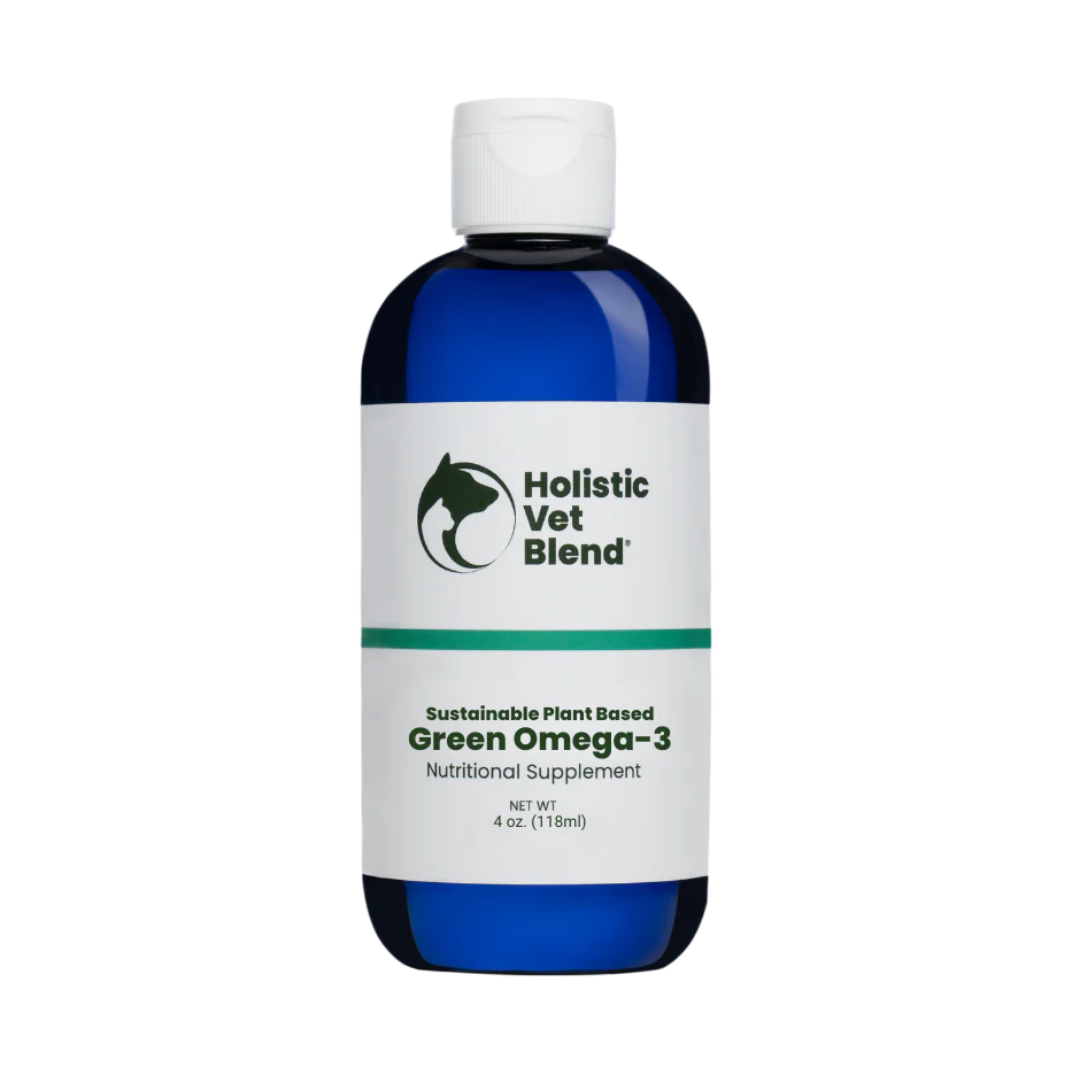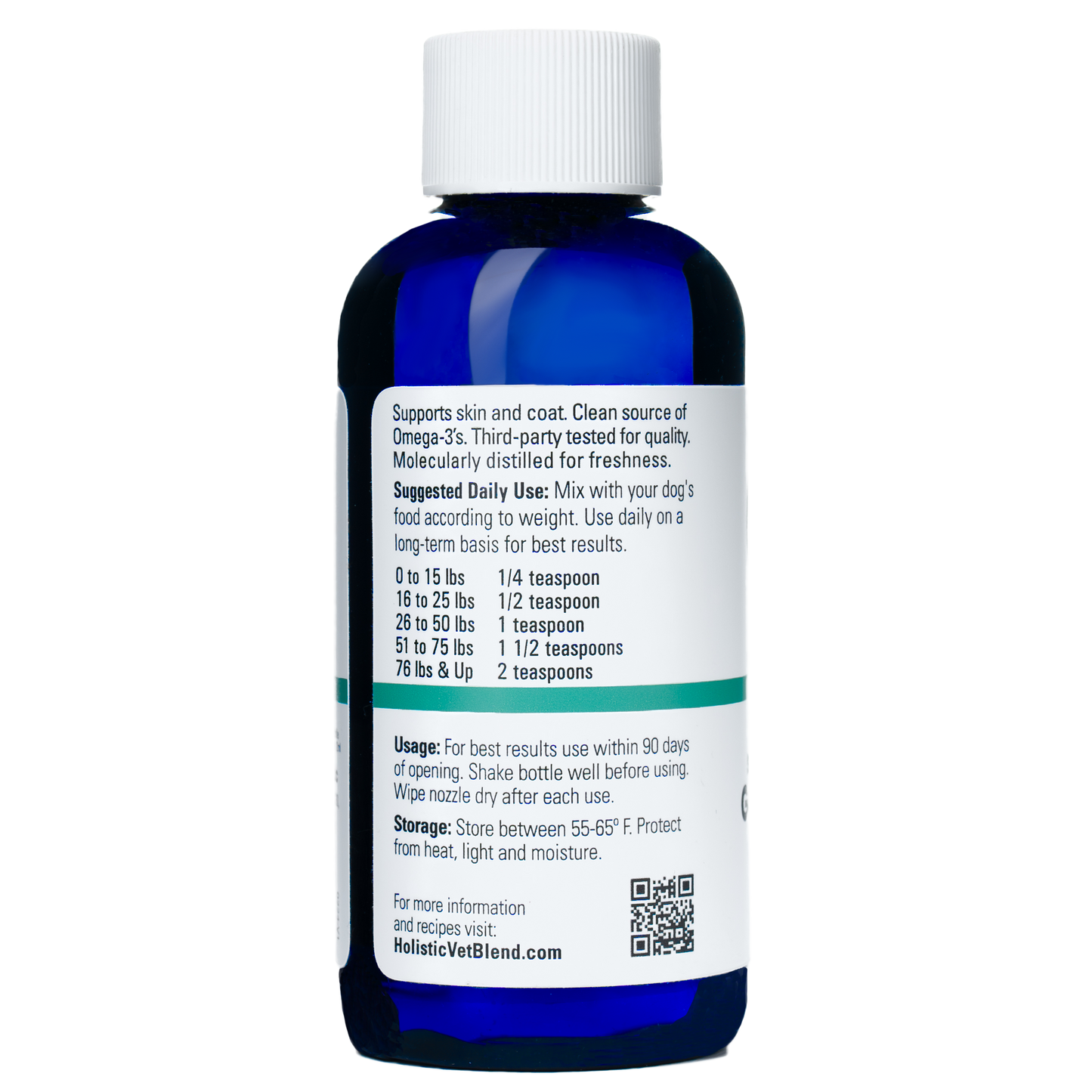
Skin allergies are one of the most common reasons dogs itch, scratch, and chew on themselves. If your dog is constantly licking their paws or has recurring ear infections, rashes, or even hives, an allergic condition could be the cause. In this comprehensive guide, we’ll explore how to manage canine skin allergies from a holistic perspective, integrating both traditional Western therapies and holistic options. We’ll cover how to diagnose food vs. environmental allergies, explain food intolerance vs. food allergy, and discuss both conventional medications and natural remedies. By the end, you’ll understand how diet (especially fresh, minimally processed food) and holistic interventions can help your itchy pup – and why a Holistic Vet Blend Canine Limited Ingredient Diet might be the perfect first step toward relief.
What are the common causes of itchy skin in dogs when no fleas are present?
Common causes of itchy skin in dogs without fleas include allergies to food, environmental factors like pollen or mold, and skin infections. Additionally, conditions such as dry skin, contact allergy, or autoimmune disorders can contribute to itching. Identifying the root cause is crucial for effective treatment and relief for your furry friend.
Types of Skin Allergies in Dogs (and How to Tell Them Apart)
Dogs typically suffer from three main types of allergies:
- Flea Allergy Dermatitis: Flea bites are a very common cause of itching. In fact, it’s estimated around 40% of dogs are hypersensitive to flea saliva. A flea-allergic dog can get intensely itchy from even one or two flea bites, especially around the base of the tail and lower back. From the beltline back fleas are the cause until proven otherwise. You might see red bumps or scabs in that area. You may also see evidence of fleas or flea dirt on your dog’s fur. Flea allergies often worsen over time – each exposure can trigger a more severe reaction. Fortunately, if you keep diligent flea control, you can largely rule out fleas as the cause. We’ll assume you have fleas under control, so we can focus on the other allergy types.
- Environmental Allergies (Atopic Dermatitis): Dogs can be allergic to things in their environment like pollens, molds, dust mites, or grasses – similar to hay fever in people, except dogs get itchy skin instead of sneezing. About 10–15% of dogs have atopic dermatitis. If your dog itches seasonally (certain times of year like spring or fall), pollen or mold is likely to blame. If symptoms happen year-round, indoor allergens like dust mites or molds could be triggers. Signs of atopy include excessive paw licking (especially chewing between toes), face rubbing, recurrent ear infections, and rashes or “hot spots” on the belly, armpits, or groin. Often, atopic dogs will start showing symptoms between 1 and 3 years of age, and many have multiple allergens. It’s not unusual for a dog with environmental allergies to also experience flea or food allergies at the same time.
- Food Allergies: True food allergies in dogs are less common than many people think. Some experts estimate that only about 1–5% of dogs are actually allergic to foods. In a genuine food allergy, the dog’s immune system overreacts to a protein in the diet (often a protein source like beef or chicken). Food allergies usually cause non-seasonal itching (itching all year long regardless of pollen seasons), often with skin problems all over the body, and least commonly exhibit digestive issues alongside skin allergies. Common offending foods for dogs include chicken, wheat, beef, dairy, egg, lamb, soy, or even other proteins. Notably, many dogs with food allergies also have another allergy at the same time – one source found ~30% of pets with food-responsive disease also have seasonal or flea allergies. This overlap can complicate diagnosis.
Key point: All these allergies can look similar in terms of the dog’s itching and skin lesions. That’s why veterinarians often need to do diagnostic trials and tests to figure out what the true cause is. The next sections will explain how to differentiate food vs. environmental allergies and the proper way to test for a food allergy by diet trial. But first, it’s important to clarify a common confusion – the difference between a food allergy and a food intolerance.
Food Allergy vs. Food Intolerance: What’s the Difference?
Many people use “food allergy” and “food intolerance” interchangeably, but medically, they are different issues:
- Food Allergy (aka food hypersensitivity) is an immune-mediated reaction to an ingredient. The dog’s immune system mistakenly identifies a protein in the food as an invader and mounts an attack, releasing histamine and other inflammatory chemicals. Food allergies in dogs often show up as skin problems – widespread itching, redness, recurrent ear infections, and surprisingly few gastrointestinal symptoms. Because it’s an immune reaction, even a small amount of the offending food can trigger symptoms.
- Food Intolerance is a non-immune reaction – essentially an abnormal sensitivity or inability to properly digest a food. Intolerances often cause gastrointestinal signs (such as chronic intermittent diarrhea, gas, or vomiting) rather than severe itching, though they can sometimes contribute to skin issues indirectly. Other intolerances could be due to food additives or naturally occurring compounds. For instance, some dogs might be intolerant to a preservative or even to by-products of high-heat cooking. Often with intolerances, no single specific ingredient can be pinpointed – it might be the overall quality, digestibility, or inflammatory nature of the diet that’s problematic.
Do they overlap? In practice, it can be hard to distinguish food allergies from intolerances, because a dog can have both. Also, the symptoms can overlap – both can cause chronic digestive issues and skin irritation. One general clue: food allergies are more likely to cause intense itching and skin inflammation, while intolerances are more likely to cause diarrhea or soft stools without the full-body itch. But there are plenty of exceptions, and some unlucky dogs have both itchy skin and an upset stomach from the food they eat.
How common are they? True food allergies (immune-based) are relatively uncommon – only a small percentage of dogs have them. Food intolerances and sensitivities (non-immune) might be a bit more common, but they’re still just one piece of the allergy puzzle. Environmental allergies and flea allergy are far more prevalent overall. However, because food is something we can control, it’s often worth investigating diet as a cause when a dog has year-round issues.
Diagnosing Allergies: Is Scratching From Food or the Environment?
Figuring out what a dog is allergic to can feel like detective work. Veterinarians approach it step by step:
1. Rule out parasites and infections first. A dog that’s itchy or has skin lesions should be checked for parasites like fleas or mites and for yeast or bacterial infections on the skin. Flea allergy, as mentioned, can be managed by strict flea control – so ensure your dog is on a quality flea preventative year-round. Your vet might do skin scrapings to look for microscopic mites (like scabies) and possibly skin cytology or cultures to see if there’s an infection. Why? Because these issues can cause similar signs (redness, itchiness, hair loss) and can even occur along with allergies. They must be treated or ruled out to get a clear picture.
2. Consider the pattern of symptoms. Your observations are important. Does the itching seem to flare seasonally (pointing to pollen, molds, etc.) or did it start after a diet change? Are the ears and rears (ears and anal area) the main problems – a pattern some vets associate more with food allergy – or is it mostly belly and feet (often atopy)? Seasonality suggests environmental allergy, while non-seasonal could be food allergy or indoor allergen. Also, very young puppies (less than 6 months) or older dogs (over 6-8 years) are less likely to suddenly develop atopic dermatitis; if they’re showing allergies at those ages, food could be more suspect. In contrast, the typical atopic dog starts showing signs of sensitive skin as a young adult (1-3 years old).
3. Testing for environmental allergies. If environmental allergies (atopy) are suspected, veterinarians can perform allergy testing – either a blood test or an intradermal skin test – to identify exactly which pollens, molds, or dust mites are triggering your dog. This can be useful if you’re considering allergen-specific immunotherapy (allergy shots or oral drops that “retrain” the immune system).
Important note: Allergy tests are not reliable for food allergies. Blood tests or hair tests that claim to detect food allergies have not been proven accurate. The only way to diagnose a food allergy is through a strict elimination diet trial (covered next). So, if your vet suspects a food allergy, they will likely skip blood testing for foods and go straight to a diet trial. There are just too many false negatives to support this type of testing.
4. The elimination diet trial (food trial). This is the gold standard to diagnose food allergies and severe intolerances. It’s so important, we’ll dedicate the next section to doing it right. In short, it involves feeding a novel diet for a set time and seeing if symptoms improve, then “challenging” with the old diet to confirm. It requires commitment, but it gives you clear answers.
Many dogs, especially those with severe atopic dermatitis, may actually have combination allergies – for example, a dog might have pollen allergies that flare in spring and also be allergic to chicken in his food year-round. It’s not uncommon for allergic dogs to have “allergic threshold” where multiple factors add up to cause itching. This is why tackling things holistically can help: by reducing any source of irritation (be it switching to a more skin-friendly diet or controlling fleas or using supplements), you might get below that threshold where your dog is comfortable.
Next, we’ll dive into the elimination diet process – a critical tool in determining if food is part of your dog’s allergy problems.
Running a Proper Food Elimination Trial
If a food allergy is suspected, your vet will likely recommend a hypoallergenic dog food elimination diet trial. This is essentially a dietary test: you feed a very restricted, hypoallergenic diet and see if your dog’s symptoms improve when all potential food triggers are removed.
How to do a food trial correctly:
- Choose the right diet: The diet must contain ingredients your dog has never eaten before (novel protein and carbohydrate), OR be a special hydrolyzed protein diet (prescription food where proteins are broken into tiny fragments the immune system won’t recognize). This could be a veterinary prescription diet or a carefully selected limited-ingredient homemade diet. The key is simplicity and novelty – for example, if your dog has only ever eaten chicken and beef kibble, you might try a diet with duck and potato as the main ingredients, or rabbit and pea, etc. A limited ingredient diet (LID) uses just one protein and one carb source to minimize variables. Many pet food companies offer LID kibbles or canned food, but be cautious: studies have found many over-the-counter “limited ingredient” diets were contaminated with proteins not listed on the label. For that reason, veterinarians often recommend using a prescription diet or a meticulously home-prepared diet for the trial. (This is where a product like Holistic Vet Blend’s Canine Limited Ingredient formula can be incredibly useful – more on that in a moment.)
- Feed exclusively the test diet: This step is vital and also the hardest for many pet owners. During the trial, no other foods or treats can be given. That means no flavored medications, no table scraps, no dental chews, not even a flavored pill pocket (use the hypoallergenic diet itself to hide pills, or get unflavored medications). The elimination diet works like an experiment – you’re eliminating all possible trigger ingredients to see if the dog gets better. Even a small lapse (like sneaking a biscuit or stealing a sibling’s food) can invalidate the results by re-exposing the allergen. Everyone in the family must be on board to strictly feed only the trial food.
- Give it enough time: For skin allergies, a food trial isn’t a quick process. Dogs can have residual allergenic compounds in their system and skin inflammation that takes time to subside. Generally, a food trial should run about 8 to 12 weeks (2 to 3 months) of strict dieting to judge improvement. In some cases you might see improvement in 4-6 weeks, but to be certain, most dermatologists advise a full 8-week minimum for dermatologic food allergies. (Trials for primarily gastrointestinal symptoms can be a bit shorter, perhaps 3-4 weeks, but for skin it’s longer.) It requires patience, but it’s worth it if you can identify a culprit.
- Monitor and record symptoms: Keep a log of your dog’s itch level, skin lesions, etc. It often helps to give a numerical “itch score” or take photos every couple of weeks. If your dog is significantly improving on the diet by the end of the trial (say, itch went from a constant 8/10 to a mild 2/10), it strongly suggests a food component to the allergy.
- Challenge to confirm: This is a critical step to avoid false conclusions. Once your dog has improved on the elimination diet, you veterinarian may advise confirming the diagnosis by reintroducing the old food (or individual ingredients) and seeing if symptoms flare up again. If the itch and redness come roaring back within days to a couple weeks of adding back the original diet, that confirms a food allergy was present. In some protocols, you reintroduce one ingredient at a time (for example, first add back chicken alone, then beef, etc.) to pinpoint which ingredient(s) cause the reaction. Many owners skip the challenge because they don’t want their pet to become itchy again – which is understandable – but technically the challenge is the only way to prove a food allergy. Without a challenge, you might be avoiding more ingredients than necessary or not be entirely sure. Talk with your vet about the best approach. Sometimes, for practicality, if a dog is much better on the diet, the owner will just continue that diet long-term and not bother challenging as long as it’s nutritionally balanced.
Using the Holistic Vet Blend Limited Ingredient formula in a food trial: One option for owners who prefer a fresh, homemade diet is the Holistic Vet Blend Canine Limited Ingredient Diet premix. This is a carefully formulated base mix (designed by a team including a holistic veterinarian, veterinary nutritionist, and PhD animal nutritionist) that contains all the vitamins and minerals your dog needs, but without common allergens. You then add your own novel protein, vegetables, and energy source to it. This approach gives you complete control over ingredients and quality, while ensuring the diet is still balanced. For example, you could use the Holistic Vet Blend Limited premix with a protein like venison or duck and a veggie like sweet potato to create a simple homemade meal that’s free of chicken, beef, dairy, wheat, and other typical allergens.
Because the HVB Limited Ingredient formula is free from typical fillers and allergens and is highly digestible, it’s ideal for dogs with sensitive systems who need a “clean slate” diet. It allows you to do an elimination trial with fresh food rather than processed kibble, which many holistic pet owners prefer. And unlike trying to devise a homemade diet from scratch (which might lack nutrients), the premix ensures your dog gets a complete spectrum of nutrients even while weeding out potential triggers. During a food trial, consistency and purity of ingredients are key, and this product can help you achieve that with confidence. (Plus, it’s much more cost-effective than many prescription diets, and dogs generally love the taste of fresh food!)
How long to use the special diet? Until the trial is complete and ideally through a challenge phase. If a food allergy is confirmed, you may choose to keep feeding a version of that limited diet long-term or slowly introduce other ingredients that may be safe. Some dogs end up able to rotate between a few proteins once they are stable, while others do best sticking to their new diet permanently to avoid relapse.
Conventional Treatments for Itching
While holistic care focuses on the root causes and long-term balance, sometimes our itchy dogs need more immediate relief. Conventional medicine has several options to manage allergic itching and establish a proper course of treatment. It’s good to understand these, even for holistic-minded owners, because you might use them in combination with natural therapies. Here are the common drug options your veterinarian might suggest, explained in everyday language:
- Glucocorticoids (Corticosteroids):
-
- Fast relief: Steroids like prednisone and dexamethasone work quickly—often within a day or two—to stop itching, redness, and swelling.
- Powerful: They’re some of the most effective anti-inflammatory drugs available, making them useful in emergency flare-ups.
- Comfort booster: Vets use them to help dogs feel better fast when allergies compromise quality of life.
- Affordable: Steroids are inexpensive compared to many newer medications.
- Short-term solution: Best used for a short time only because long-term use can cause problems (like weight gain, muscle loss, or increased infection risk).
- Double-edged sword: While they’re great for quick relief, they can cause serious side effects if used too often or for too long.
- Holistic care tip: In natural/holistic medicine, we try to avoid frequent steroid use by improving diet, reducing allergens, and using supplements—but steroids can still be helpful when nothing else is working.
- Cyclosporine:
-
- Immune system modulator: Cyclosporine was originally discovered in soil fungi and works by calming down overactive immune cells involved in allergic reactions (especially T-lymphocytes).
- Used for chronic allergies: It’s often prescribed for chronic environmental allergies (atopic dermatitis) that don't improve with diet or supplements alone.
- Slower to act: Unlike steroids, cyclosporine takes a few weeks to kick in—but it can be effective for longer-term control.
- More focused than steroids: It doesn’t have the dramatic short-term side effects like thirst, hunger, or panting that steroids do, and it’s less likely to harm organs with long-term use—but it still mildly suppresses the immune system.
-
Potential long-term concerns:
- Can increase the risk of opportunistic infections (especially fungal).
- May lead to overgrowth of gums or warts (papillomas).
- There's some concern about cancer risk—in humans and lab animals, long-term immune suppression is associated with increased cancer risk, and while no strong evidence proves it causes cancer in dogs, many holistic vets urge caution.
- Use when truly needed: From a holistic standpoint, cyclosporine should be reserved for more severe allergy cases—when lifestyle changes, diet, and natural therapies haven't provided enough relief.
- Can be combined with natural support: Omega-3 fatty acids (from fish oil or algal oil) may enhance its effect, allowing for a lower dose—a great example of combining holistic and conventional tools.
- Costs add up: It can be pricey, especially for larger dogs on daily doses.
- Holistic takeaway: Cyclosporine can be part of a treatment plan, but we aim to use it sparingly and support the body naturally whenever possible. It’s not a “natural fix,” but it can bring relief while we work to resolve the root cause of your dog’s allergies.
- Apoquel
-
- How it works: Apoquel is a Janus kinase (JAK) inhibitor—it blocks specific signals in the body that tell your dog to itch and swell in response to allergens.
- Works quickly: One of its biggest advantages is speed—itching can improve within a day or two, making it a go-to for fast relief.
- Helps with allergic skin disease: It's often used for atopic dermatitis, food allergies, and other allergy-related skin conditions.
-
Holistic concerns:
- Apoquel suppresses parts of the immune system, which may help reduce inflammation—but over time, this can interfere with natural immune surveillance, the body’s way of checking for infections or abnormal cells (like tumors).
- There are concerns about increased risk of infections, demodex mites, and possibly even cancer in long-term use—especially in immune-compromised pets or seniors.
- It doesn’t treat the underlying cause of allergies—it just stops the signal to itch.
- Use with intention: From a holistic viewpoint, Apoquel shouldn’t be the first line of defense. It may be helpful during severe flares or as a short-term bridge while working on long-term solutions like diet, detox, and immune support.
- Not ideal for puppies or long-term in young dogs: Apoquel is not approved for dogs under 1 year of age, partly due to concerns about serious infections and immune development.
- Holistic strategy: If Apoquel is used, it should be paired with natural therapies like fish oil, probiotics, and food allergy trials to reduce the need for long-term medication.
- Cytopoint (Lokivetmab): Targeted Itch Relief with Minimal Side Effects
-
- How it works: Cytopoint is a monoclonal antibody (a lab-made protein) that blocks IL-31, the main itch signal in dogs. Think of it like a guided missile that finds and neutralizes the “itch” message before it reaches the brain.
- Great for atopic dermatitis: It’s commonly used for dogs with environmental allergies, especially if their symptoms are mostly itch without much swelling.
- Gentler on the body: Cytopoint doesn’t suppress the immune system broadly, making it a better option for dogs that can’t tolerate steroids or Apoquel. It can be safely used in dogs with other health issues and in younger dogs.
- Convenient: It's given as a monthly injection at the vet’s office and starts working in 1–3 days, with effects lasting 4–8 weeks.
-
Holistic insights:
- Many holistic vets consider Cytopoint a safer pharmaceutical option compared to Apoquel or steroids, especially for long-term use.
- Cytopoint targets only IL-31, the cytokine responsible for sending the itch signal to the brain. Unlike Apoquel or steroids, it does not broadly suppress the immune system.
- Some dogs stop responding over time or may need increasing doses, so it's still important to work on root causes like diet and environment. Some dogs will actually get worsening of ear infections.
- Use with strategy: Cytopoint may be appropriate for dogs who can’t tolerate other drugs or as a tool to buy time while implementing deeper, more holistic interventions.
- Best when part of a full plan: Combine Cytopoint with fresh food, omega-3s, environmental detox, and gut support to reduce the need for repeated injections.
- However, itching is often the early warning sign of an underlying skin or ear issue. By turning off the itch signal, Cytopoint may mask early symptoms of inflammation, allowing an ear infection or skin infection to develop before it’s noticed.
- In clinical studies, Cytopoint did not significantly increase the risk of secondary infections like otitis externa (ear infections). But real-world reports like myself and pet owners have sometimes observed increased ear infections or skin infections during treatment—particularly in dogs already prone to these issues.
Holistic Perspective:
- Dogs with atopic dermatitis often have an imbalance in skin and ear flora due to their allergies and a weakened skin barrier.
- When you block the itch without addressing the underlying gut, diet, immune balance, or yeast overgrowth, you may temporarily relieve symptoms while the root issue worsens behind the scenes.
- If a dog has a history of chronic yeast or bacterial ear infections, and they’re on Cytopoint, it's important to proactively support the skin and immune system (e.g., with omega-3s, probiotics, antifungal ear cleaners, etc.)
Final Holistic Tip:
Drugs like Apoquel and Cytopoint can offer real relief, and there’s no shame in using them when your dog is suffering. But the goal in holistic care is to use them as tools, not crutches—work on healing the body from within with diet, immune support, and toxin reduction so your dog can thrive naturally with less or no medication.
Holistic Tips for All Medications:
- Always support with anti-inflammatory diet, omega-3s, and probiotics.
- Address underlying allergies through elimination diets or environmental management.
- Use medication as part of a multimodal plan, not the sole solution.
Conventional Vets Move Away From Antibiotics For Shampoos
Due to antibiotic resistance, veterinarians are moving away from using antibiotics in favor of topical treatment of skin infections.
Note: Often a multimodal approach is used. For example, during a severe flare-up, a dog might get a steroid injection for quick relief, be started on Apoquel for maintenance, and also be on fish oil supplements and a special diet for long-term management. The goal is to use the lowest amount of medication possible to keep the dog comfortable, and that’s where holistic strategies come in – they can bolster the dog’s skin health and immune balance, potentially reducing the dosage or need for the stronger drugs.
Now, let’s talk more about the role of nutrition and holistic remedies in managing allergies. These can improve your dog’s condition from the inside out, addressing underlying inflammation and strengthening the skin barrier.
The Role of Diet: Processed vs. Fresh Foods in Allergies
A dog’s diet can significantly impact their skin health and immune function. Here are some dietary considerations for allergic dogs:
- Ultra-processed diets (kibble, canned food) – Most commercial dog foods are highly processed, cooked at high temperatures, and contain various additives (preservatives, artificial flavors, etc.). High-heat processing can create advanced glycation end-products (AGEs) and other compounds that may promote inflammation or gut dysbiosis. Some dogs might not outright “allergic” to these diets, but they may not thrive on them either. There’s evidence that food additives or by-products of processing (like the Maillard reaction products) can contribute to food intolerances. Additionally, many kibbles are high in omega-6 fatty acids (from grains or cheap seed oils) and low in omega-3s, leading to an imbalance. Omega-6s tend to be pro-inflammatory when not balanced with omega-3s.
- Fresh, minimally processed diets – On the other hand, fresh diets (whether home-cooked, freeze-dried, or raw) that use whole ingredients can be easier to digest and contain more natural nutrients. They often avoid many of the chemicals found in kibble. A minimally processed diet is also more likely to have a healthier omega-6 to omega-3 ratio, which can reduce inflammation. Many owners report improvements in their dog’s coat quality and reduction in itching after switching from a low-quality kibble to a high-quality or homemade diet. Fresh diets can include commercial fresh-frozen foods, dehydrated bases (like Holistic Vet Blend premixes with added fresh meat), or completely home-cooked recipes – but it’s crucial that any long-term diet be nutritionally balanced. Working with a holistic vet or using a formulated base (like HVB) helps ensure your fresh diet isn’t missing any vitamins or minerals.
- Hypoallergenic ingredients – When formulating a diet for an allergic dog, whether short-term for a trial or long-term for management, think about using novel, high-quality ingredients. Novel proteins (duck, venison, rabbit, fish like salmon) and novel carbs (sweet potato, quinoa, etc.) can reduce the chance of triggering a known allergy. These ingredients should be as pure as possible – organic or free-range meats and organic produce if available – to minimize pesticide or antibiotic residues that could affect gut health. Some holistic vets also suggest avoiding common inflammatory ingredients like corn, soy, wheat, and artificial additives for dogs with skin issues, even if not “allergic” to them, on the principle that a cleaner diet supports a healthier immune system.
- Digestive health – Allergies are tied to the gut in many ways. About 70% of the immune system is associated with the gut, and a balanced gut microbiome can help regulate immune responses (potentially reducing overreactions that cause allergies). Diets that are rich in natural fiber, fermented foods, or supplemented with probiotics can improve gut health. There’s emerging research that certain probiotic strains may help alleviate atopic dermatitis in dogs by modulating immune function. While more studies are needed, it’s reasonable to include a canine-specific probiotic or feed things like plain unsweetened yogurt or kefir (if tolerated) to support gut flora.
- Elimination of synthetic additives – Many holistic practitioners recommend avoiding foods with artificial colors, flavor enhancers, and preservatives like BHA, BHT, ethoxyquin, etc., for allergic dogs. These additives might not directly cause allergies, but they could cause low-grade chronic inflammation or just burden the body’s detox systems. Sticking to natural, whole-food-based diets avoids these questionable additives.
Diet and the Skin Barrier
In summary, feeding a fresh, whole-food diet (appropriately balanced for dogs) can strengthen your dog’s overall health, which in turn can make them more resilient to environmental allergens. Good nutrition can improve the skin barrier (the first line of defense against allergens) and provide anti-inflammatory benefits. For example, diets naturally high in omega-3 fatty acids and antioxidants will help calm inflammation. In fact, one study showed that feeding a diet enriched with omega-3s, antioxidants, and polyphenols significantly reduced dogs’ allergic skin symptoms and itching over a 60-day period.
If you’re not ready to cook homemade meals for your dog, you can still improve their diet: opt for a high-quality, limited-ingredient commercial food or consider a compromise, such as mixing fresh food with kibble. Of course, if you’re conducting a strict food trial, you’ll want to restrict your dog to the trial food only. However, once you identify safe foods for your dog, a fresh diet focused on those ingredients is an excellent long-term strategy. While there are supplements that can improve allergy symptoms, you cannot supplement your way out of a bad diet. “You are what you eat” applies to our furry friends, too.
Holistic Remedies and Supplements for Canine Allergies
Beyond diet changes, there are several natural supplements and holistic therapies that can help manage a dog’s allergic condition. These can often be used alongside conventional meds or, in some cases, may reduce or replace the need for drugs.
Here are some evidence-supported holistic interventions:
- Omega-3 Fish Oil (EPA/DHA): Omega-3 fatty acids from fish oil are one of the most widely recommended supplements for dogs with skin issues. These fatty acids (EPA and DHA) have potent anti-inflammatory properties. They work by altering the cell membranes and the types of inflammatory chemicals the body produces. In allergic dogs, omega-3s can help reduce itching, improve skin and coat quality, and even restore the skin barrier. Clinical research supports their benefits: in a 10-week study, dogs with atopic dermatitis who were supplemented with omega-3 rich oils showed improved clinical scores (less itching and irritation) compared to dogs given a placebo. Other studies have found that adding fish oil can allow veterinarians to lower the dose of steroid or cyclosporine needed to control symptoms. Fish oil is safe for most dogs; the main side effect if given in high doses is loose stools or fishy breath. It’s important to use a high-quality, purified fish oil made for pets (to avoid heavy metal contaminants). Dose matters – typically a therapeutic dose might be around 50-100 mg of EPA/DHA combined per kg of the dog’s body weight (your vet can guide you). Results aren’t instant; it can take 6-8 weeks to see the full anti-itch effects. Many holistic vets consider fish oil a cornerstone of allergy management. (Note: plant-based omega-3s like flaxseed oil are sometimes used, but dogs don’t convert them to EPA/DHA efficiently. Fish or algal sources are best for direct EPA/DHA.)
- Quercetin (with Bromelain): Quercetin is a natural bioflavonoid found in many fruits and vegetables (like apples and leafy greens). It has earned the nickname “Nature’s Benadryl” because of its anti-histamine and anti-inflammatory effects. Quercetin can stabilize mast cells (the cells that release histamine) so they are less likely to dump histamine in response to allergens. A landmark study in 1998 showed quercetin significantly reduced histamine release from dog immune cells, and subsequent research (2004) indicated dogs receiving quercetin had less severe allergic skin reactions compared to a placebo group. This is promising, though large-scale clinical trials in pet dogs are still limited. Quercetin also inhibits certain inflammatory pathways (like leukotrienes and prostaglandins), acting as a broad anti-inflammatory agent. For better absorption, quercetin is often given with bromelain (an enzyme from pineapple) which may help increase its bioavailability and also has anti-inflammatory effects. You can find combo supplements of quercetin+bromelain marketed for pets. Dosing is roughly 5-10 mg per kg of body weight for quercetin, given twice daily (under veterinary guidance). Safety: Quercetin is quite safe; side effects are rare (at very high doses it could potentially stress the kidneys, so don’t massively overdose). Many owners see improvements in itchiness and red skin after a few weeks of use, though about 20-30% of dogs might not respond dramatically – individual variation exists, just as with antihistamines. Still, considering the low risk, it’s certainly worth trying for an allergic dog. Tip: It may work best as a preventative (similar to antihistamines), so daily use during allergy season or even year-round for atopic dogs can help take the edge off the allergic response.
- Turmeric (Curcumin): Turmeric is the golden-colored spice famous for its use in curries, and its active component curcumin is a powerful natural anti-inflammatory. In traditional Ayurvedic and Chinese medicine, turmeric has been used for its anti-allergy and healing properties. Curcumin has been shown to modulate the immune system – for example, it can help balance out an overactive Th2 immune response (the kind involved in allergies) and shift it to a more normal state. In lab studies and rodent models, curcumin demonstrates anti-allergic effects: it can inhibit the release of histamine and pro-inflammatory cytokines, and even reduce IgE (the allergy antibody) production. One study on mice with allergy found that turmeric supplementation significantly reduced their allergy symptoms and IgE levels (promising, though not yet replicated in dogs). Anecdotally, some holistic vets report that giving dogs turmeric or its extracts helps lessen itch and skin lesions over time. The challenge with turmeric is absorption – curcumin isn’t absorbed well on its own. It’s usually given as curcumin extract with a booster like black pepper extract (piperine) or formulated as “Golden Paste” (turmeric mixed with coconut oil and a bit of black pepper) to improve uptake. If you try turmeric for your dog, consider a veterinary supplement that contains curcumin phytosome (a form bound to phospholipids for better absorption) or use a proven recipe for golden paste. Safety: Turmeric is safe for dogs in moderate amounts. High doses could cause stomach upset or constipation. Also, because it has mild blood-thinning properties, use caution if your dog will have surgery or is on blood-thinning meds. A typical dose might be around Turmeric's anti-inflammatory effect can take a few weeks to show, and it’s often one piece of a multi-modal plan. While not a stand-alone cure, it can support overall inflammation control and comfort.
- Acupuncture: Acupuncture is a component of Traditional Chinese Veterinary Medicine (TCVM) that involves inserting fine needles into specific points on the body to achieve a therapeutic effect. For allergies, acupuncture can be surprisingly helpful for some dogs. It’s thought to work by multiple mechanisms: it can release endorphins (natural pain relief and feel-good hormones), improve blood circulation, and modulate the immune system. In the TCVM view, acupuncture helps resolve underlying imbalances (often “heat” or “wind” in the skin for allergic dogs). From a Western viewpoint, studies have indicated that acupuncture can reduce itching sensation by affecting neurotransmitters and can prolong the intervals between allergy flare-ups. For example, there are case reports of dogs whose need for frequent steroid injections dropped significantly after they started routine acupuncture sessions – their itch levels became more manageable and their skin improved. Acupuncture is especially appealing because it has virtually no side effects when performed by a trained veterinary acupuncturist. The needles don’t typically hurt (most dogs relax or even fall asleep during treatment!). A typical regimen might be one session a week for 4-6 weeks, then tapering to maintenance sessions monthly or seasonally as needed. Not every dog responds, but many do, and owners often report overall improvements in vitality and stress levels too. If your budget allows and you have a qualified vet acupuncturist nearby, it’s certainly worth a try as part of a holistic allergy plan.
- Chinese Herbal Medicine: In addition to acupuncture, TCVM uses herbal formulations to treat allergies. Always involve a knowledgeable veterinarian – do not randomly give your dog human herbal supplements, as some can be toxic to pets.
-
Other herbs and natural remedies: Beyond the heavy-hitters above, there are various other herbal or natural therapies people use for allergic dogs:
- Adaptogenic herbs like Astragalus or Ashwagandha might support the immune system and stress response (helpful since stress can worsen itching).
- Stinging Nettle – an herb that in humans can act like a natural antihistamine. Some canine supplements include nettle for allergy relief.
- Licorice root – contains glycyrrhizin which has a corticosteroid-like action (anti-inflammatory). In fact, licorice is often in Chinese formulas for its synergistic effects. On its own, long-term high doses of licorice could affect a dog’s hormones, so it’s used in moderation.
- Topical herbal and home remedies: Using natural shampoos with oatmeal, aloe vera, or green tea extracts can soothe itchy skin. Baths with chamomile or calendula tea can calm hot, red skin. Coconut oil topically (or given orally in small amounts) has anti-inflammatory and anti-fungal properties that can be beneficial if the skin is dry or yeasty.
- Probiotics and prebiotics: As mentioned under diet, supporting the gut microbiome is a holistic way to influence the immune system. Specific probiotic strains (like Lactobacillus rhamnosus GG, or L. sakei probio65 in some studies) have shown reductions in skin allergy severity. While not an “herb,” probiotics are natural supplements that can be part of an integrative approach.
- Vitamin E and other antioxidants: Allergic inflammation causes oxidative stress in the body. Supplements like vitamin E (which is also an anti-inflammatory at higher doses) or bioflavonoids (like rutin, hesperidin) may aid in skin health. Consult your vet for appropriate dosing.
All these holistic options can seem overwhelming, but you don’t need to use every single one. A common strategy is to start with one or two supplements at a time and see how your dog responds. For example, it’s very popular to pair fish oil + quercetin as a starting point: fish oil to broadly lower inflammation and quercetin to reduce histamine-driven itching. You might also use a topical therapy (like an oatmeal rinse or medicated shampoo) for immediate relief on the skin while the supplements and diet do their work internally. If the dog still needs more help, you can add acupuncture or an herbal formula. Over time, you and your vet can adjust the regimen – maybe during heavy pollen season your dog gets Cytopoint shots and weekly acupuncture plus his daily fish oil and turmeric, but in winter you scale back to just diet and quercetin, for instance.
The beauty of holistic medicine is that you are addressing the whole animal – diet, mind, body – rather than just suppressing symptoms. Many owners find that with the right combination of nutritional support and natural remedies, their dogs not only itch less but also have more energy and overall vitality. It does require commitment (e.g. cooking meals or remembering supplement doses), but seeing your best friend comfortable in their skin is worth it!
Conclusion: A Holistic Path to Itch-Free Living (Try Holistic Vet Blend Limited Ingredient Diet!)
Managing your dog’s skin allergies may feel like a journey, but with a holistic game plan, relief is absolutely possible. We’ve discussed how proper diagnosis – especially ruling out foods via an elimination diet – is the foundation. We’ve seen that food allergies are uncommon but real, and food intolerances can aggravate your pup’s problems, so it’s wise to feed the best diet you can. We’ve also covered the conventional tools (from steroids to Cytopoint) that can rescue a dog in a bad flare, and how natural interventions like omega-3s, quercetin, turmeric, acupuncture, and herbs can provide lasting support and reduce the need for heavy medications.
Perhaps the most important takeaway is that diet is the cornerstone of holistic health. By eliminating common allergens and feeding fresh, anti-inflammatory foods, you set up your dog’s body to heal and handle allergens better. This is exactly why we encourage you to try the Holistic Vet Blend Canine Limited Ingredient Diet for your allergic dog. This special formula gives you an easy way to provide home-cooked purity with complete nutrition – it’s a labor of love for your dog that can yield amazing results. Many pet parents have watched their dogs transform on a limited ingredient, whole-food regimen: less itching, no more recurrent ear infections, a shiny coat, and more happy tail wags.
Don’t let skin allergies hold your dog back from living their best life. Take action today: put on your holistic detective hat and start with the simplest, most impactful change – their food. We’ve seen how Remington the dog thrived once on a limited ingredient diet, and your dog could be the next success story. By choosing Holistic Vet Blend, you’re not just buying a product – you’re joining a community dedicated to natural, optimal health for pets.
Give it a try and see the difference in your furry friend’s comfort and happiness. With patience and the right care, your itchy pup can become an allergy-free, tail-wagging testament to the power of holistic healing. Together, let’s help your beloved companion enjoy life to the fullest – itch-free and thriving!





